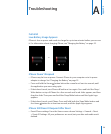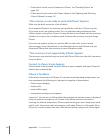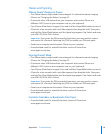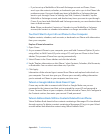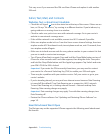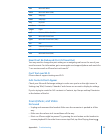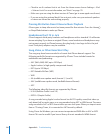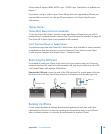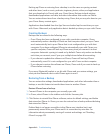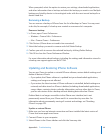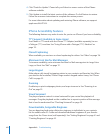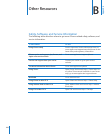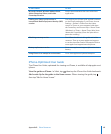
138 Appendix A Troubleshooting
Check to see if a volume limit is set. From the Home screen choose Settings > iPod
> Volume Limit. For more information, see “Music” on page 115.
Make sure you are using the latest version of iTunes (go to www.apple.com/itunes).
If you are using the optional dock’s line out port, make sure your external speakers
or stereo are turned on and working properly.
Pressing Mic Button Doesn’t Resume Music Playback
iPhone goes to sleep after music has been paused for five minutes. Press the Home
or Sleep/Wake button to wake up iPhone.
Headphones Don’t Fit in Jack
iPhone supports third-party headsets and headphones with a standard 3.5 millimeter
stereo miniplug. If you have an original iPhone, some headsets and headphones may
not connect properly to iPhone because the plug body is too large to fit in the jack
inset. Third-party adapters may be available.
Song, Video, or Other Items Won’t Play
The song may have been encoded in a format that iPhone doesn’t support. The
following audio file formats are supported by iPhone. These include formats for
audiobooks and podcasting:
AAC (M4A, M4B, M4P, up to 320 Kbps)
Apple Lossless (a high-quality compressed format)
MP3 (up to 320 Kbps)
MP3 Variable Bit Rate (VBR)
WAV
AA (audible.com spoken word, formats 2, 3, and 4)
AAX (audible.com spoken word, AudibleEnhanced format)
AIFF
The following video file formats are supported by iPhone:
H.264 (Baseline Profile Level 3.0)
MPEG-4 (Simple Profile)
A song encoded using Apple Lossless format has full CD-quality sound, but takes up
only about half as much space as a song encoded using AIFF or WAV format. The same
song encoded in AAC or MP3 format takes up even less space. When you import music
from a CD using iTunes, it is converted to AAC format by default.
Using iTunes for Windows, you can convert nonprotected WMA files to AAC or MP3
format. This can be useful if you have a library of music encoded in WMA format.




